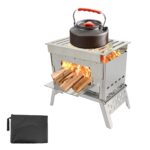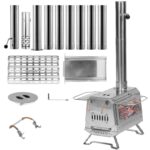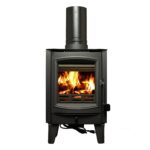
Introduction to Portable Wood Burning Camping Stoves
Portable wood burning camping stoves are innovative cooking devices designed for outdoor enthusiasts who desire the comforts of cooking while enjoying nature. Unlike traditional camping stoves, which typically rely on propane or other fuel sources, these stoves utilize natural materials, making them an environmentally friendly option. This unique feature allows campers to utilize available resources while minimizing their carbon footprint, aligning with a growing emphasis on sustainability in outdoor activities.
One of the significant advantages of portable wood burning camp stoves is their convenience. These stoves can operate with readily available fuel, such as twigs, branches, and other biomass found in the environment, eliminating the need to carry heavy propane canisters. This reduces the weight and bulk of a camper’s gear, enabling a more enjoyable hiking experience. Moreover, wood burning stoves can often generate more heat than their gas counterparts, providing a reliable cooking solution even in challenging weather conditions.
With varying designs and functionalities, portable wood burning camping stoves cater to different cooking styles and preferences. Some models incorporate advanced features, such as adjustable air controls for temperature regulation, while others focus on simplicity and ease of use. Regardless of the type chosen, these stoves are generally compact and lightweight, making them an ideal addition to any camping gear checklist.
As outdoor enthusiasts seek reliable and effective ways to prepare meals in the wilderness, the relevance of portable wood burning camping stoves continues to grow. By combining eco-friendliness with practical design, these stoves represent a versatile cooking solution that meets both the needs of campers and the demands of our environment.
Benefits of Using Portable Wood Burning Camping Stoves
Portable wood burning camping stoves offer immense advantages to outdoor enthusiasts, positioning themselves as essential equipment for any camping trip. One of the primary benefits is the availability of fuel; wood is generally abundant in nature, making it an easy and accessible resource. Unlike gas canisters, which can be difficult to source in remote areas, wood is often found nearby, whether in the form of fallen branches or twigs. This convenience allows campers to set up a cooking station without the worry of running out of fuel.
Another significant advantage is the cost-effectiveness provided by wood burning stoves. Once the initial investment in the stove is made, the ongoing costs are minimal, as wood is typically free. This financial saving is particularly beneficial for frequent campers who might otherwise need to purchase gas canisters regularly. By reducing reliance on commercial fuel sources, outdoor adventurers can allocate their funds towards other essentials for their trips.
Furthermore, using wood for cooking can vastly improve the flavor of meals. The smoky aroma infused into food cooked over an open flame creates a unique taste that is difficult to replicate using conventional stoves. Many outdoor chefs appreciate this aspect, as cooking with wood can enhance the overall dining experience while enjoying the great outdoors.
In terms of environmental impact, wood burning camping stoves provide benefits over traditional fuel options. Utilizing natural materials leads to a decrease in reliance on fossil fuels and minimizes carbon footprints. When used responsibly, wood camping stoves can support sustainable outdoor practices, as they promote a connection with nature while prioritizing eco-friendliness.
Ultimately, the combination of accessibility, affordability, enhanced culinary experiences, and environmental consciousness makes portable wood burning camping stoves a highly advantageous option for those seeking to relish their outdoor adventures fully.
Key Features to Look for in a Portable Wood Burning Camping Stove
When selecting a portable wood burning camping stove for your outdoor excursions, it is essential to consider several key features that enhance usability, efficiency, and overall functionality. First and foremost, size and weight play critical roles in portability. A compact stove will be easier to pack and carry, while a lightweight design contributes to reduced load during hikes. Therefore, examining the dimensions and weight specifications is essential in ensuring the stove meets your mobility needs.
Material quality is another important aspect. Camping stoves made from durable materials such as stainless steel or high-grade aluminum offer longevity and resistance to the rigors of outdoor use. These materials not only withstand high temperatures but also provide reliable performance in various environmental conditions, necessitating careful consideration during your selection process.
Ease of assembly and disassembly cannot be overlooked. A well-designed stove should allow for quick setup and takedown, helping campers save time and energy, especially in adverse weather conditions or when time is of the essence. Features such as collapsible components or integrated systems can significantly enhance the assembly experience.
Airflow control is another pivotal feature, directly influencing combustion efficiency and cooking performance. Stoves that offer adjustable airflow mechanisms enable users to manage the intensity of the fire, allowing for optimized cooking processes and better fuel efficiency. Also, consider the cooking surface area. A larger cooking space will accommodate multiple pots or pans, which can be particularly advantageous when preparing meals for a group.
Lastly, additional features such as built-in fans or grilling grates can enhance the stove’s versatility. A fan can improve combustion while ensuring the cooking process is quicker and more efficient. Grilling grates offer an alternative cooking option, expanding the range of meals you can prepare while camping. When evaluating portable wood burning camping stoves, keeping these key features in mind will surely lead to a more enjoyable outdoor cooking experience.
Top Recommendations for Portable Wood Burning Camping Stoves
When it comes to selecting the ideal portable wood burning camping stove, several options stand out in the market, each offering unique features tailored for outdoor enthusiasts. Below is a curated list of top recommendations that cater to various needs and preferences.
Solo Stove Lite: This compact and efficient stove is crafted from high-grade stainless steel and is perfect for solo campers. Weighing only 9 ounces, it utilizes a unique design that enhances airflow for better combustion, ensuring minimal smoke production. Pros include its lightweight construction and easy setup, while the con is its small cooking capacity, suitable mainly for one or two individuals.
Camp Chef Alpine Heavy Duty: The Camp Chef Alpine stove is designed for serious camping and backpacking experiences. With a durable steel construction and a heat-resistant finish, it can handle intensive cooking duties. This model offers stability and a larger cooking surface, making it suitable for families or groups. However, its heavier weight may deter solo hikers.
BioLite CampStove 2: This innovative model uses wood as fuel while providing USB charging capability for small devices. Weighing about 2 pounds, it combines functionality and environmental consciousness. The benefit lies in its dual-purpose design, but one potential drawback is the higher price point compared to traditional stoves.
湖北户外露营木材炉 (Hubei Outdoor Camping Wood Stove): Known for its versatility, this stove features a multi-fuel option, allowing users to burn wood, charcoal, or even biomass. It is foldable and portable, making it ideal for various outdoor settings. An advantage of this model is its adaptability; however, assembly can be slightly complex for some users.
Choosing an appropriate portable wood burning camping stove comes down to personal camping style, group size, and specific cooking requirements. By evaluating these top recommendations, campers can intelligently invest in a stove that best suits their outdoor adventures.
Comparing Wood Burning Stoves with Other Camping Stove Types
When choosing a camping stove, outdoor enthusiasts often weigh the benefits and drawbacks of various fuel types. Among these are portable wood burning stoves, propane stoves, and butane stoves. Each has its own unique attributes, impacting performance, fuel availability, cost, and environmental considerations.
Portable wood burning stoves offer a significant advantage in terms of fuel availability. Wood is often abundant in natural environments, allowing campers to gather fuel on-site without the need to carry extra canisters. This accessibility not only simplifies logistics but also reduces reliance on commercially produced fuel, making wood burning stoves a more sustainable choice. However, the need for dry, combustible wood can sometimes limit their efficiency, especially in wet conditions.
In contrast, propane and butane stoves utilize gas canisters, which can be pre-purchased and provide a ready supply of fuel. These gas stoves usually ignite quickly and maintain consistent heat output, making them remarkably convenient for quick meal preparation. However, users must ensure they bring enough fuel, which adds weight to their pack and may complicate logistics for longer trips.
From a cost perspective, portable wood burning camping stoves tend to have a one-time purchase price that can be more economical over the long run, given the negligible cost of naturally sourced wood. Conversely, propane and butane options may involve recurring costs for fuel canisters, which can add up over time, especially for frequent outdoor adventures.
Finally, the environmental impact of each stove type is noteworthy. Wood burning stoves produce emissions, though this can be mitigated by using sustainably sourced wood. Alternatively, propane and butane stoves typically have fewer particulate emissions but still rely on fossil fuels, raising concerns about carbon footprints. Ultimately, the choice of stove depends on individual priorities regarding convenience, sustainability, and long-term costs.
Safety Tips and Best Practices for Using Wood Burning Stoves
Operating a wood burning camping stove requires careful attention to safety and best practices to ensure a secure and enjoyable outdoor cooking experience. First and foremost, selecting a safe cooking area is vital. It is advisable to set up the stove on a level, stable surface, away from overhanging branches and flammable materials. A designated fire site or a compact area free of combustible vegetation can help minimize the risk of accidental fires.
Maintaining a safe distance from flammable objects is equally critical. All surrounding items, including tents, backpacks, and paper goods, should be kept at least three feet away from the stove. This buffer zone will significantly reduce the likelihood of unintentional ignitions. Furthermore, the use of a fireproof mat or platform underneath the stove can offer additional protection for the ground and surrounding fabrics.
Proper ventilation is essential when using wood burning stoves, particularly in enclosed spaces. Children and pets should be kept at a safe distance to prevent any risk of burns or exposure to smoke. Additionally, ensure that the cooking area is well-ventilated to disperse smoke and prevent it from accumulating. Regularly checking the operation of your stove, including the flue and any exit points for smoke, aids in preventing dangerous buildup and maximizes efficiency.
Lastly, responsible fire management practices must be observed. This includes never leaving a wood burning stove unattended while in use, extinguishing the fire completely before leaving the site, and adhering to any local regulations regarding fire usage and restrictions. Collecting and using fallen, seasoned wood not only ensures a safer burn but also helps maintain the sustainability of the environment. Being mindful of these safety considerations will enhance your enjoyment of wood burning camping stoves and help ensure a safer outdoor cooking experience.
How to Efficiently Gather Fuel for Your Wood Burning Stove
When embarking on an outdoor adventure that involves the use of portable wood burning camping stoves, one of the most important considerations is how to gather fuel effectively. The efficiency of your stove heavily relies on the quality and preparation of the firewood you collect. To start, it is crucial to identify suitable types of firewood. Hardwoods such as oak, maple, and hickory are preferable due to their high density and energy content, resulting in longer burn times and higher heat output compared to softwoods.
When gathering firewood, always practice sustainability. This involves selecting dead or downed wood rather than cutting live trees, which can harm the environment and disturb local wildlife. Look for fallen branches or logs that have been naturally shed by trees. If you must gather firewood from living trees, prioritize small branches that are already dead and do not strip the bark or damage the ecosystem. Local regulations may govern wood collection, so it is advisable to familiarize yourself with the guidelines of the area you are camping in.
Once you have collected your firewood, processing it properly can enhance its burning efficiency. For optimal performance in your portable wood burning stove, consider splitting larger logs into smaller pieces. Splitting increases the surface area, allowing for better airflow and more efficient combustion. Additionally, dry wood burns significantly better than wet wood. If possible, gather wood that has been seasoned and stored correctly, or dry it by exposing it to sun and air for a few hours before use. Properly prepared firewood combined with efficient gathering techniques will help ensure consistent heat and a satisfying cooking experience during your camping excursions.
Cleaning and Maintaining Your Portable Wood Burning Stove
To ensure the longevity and optimal performance of your portable wood burning camping stove, regular cleaning and maintenance are essential. After each use, allow the stove to cool down completely before starting the cleaning process. The first step is to remove any ash and charcoal residue. This can be done by using a small shovel or a brush to scoop out the remaining materials. Ensure that all debris is cleared, as leftover ash can retain moisture and lead to rust if not addressed.
Next, inspect your stove for any signs of damage. Check for cracks, dents, or rust, particularly in areas that are exposed to high heat. Any visible damage should be assessed carefully; minor imperfections can often be repaired, but significant damage may require replacement parts. It’s also advisable to examine the seals and gaskets, if applicable, to ensure they are intact and functioning properly, as these components can affect the stove’s efficiency and safety.
Proper storage is another crucial aspect of maintaining your portable wood burning stove. When not in use, store the stove in a cool, dry place to protect it from moisture and extreme weather conditions, which can lead to significant deterioration over time. Consider using a dedicated storage bag, if available, to shield the stove from dust and dirt. It is advisable to periodically re-evaluate the condition of the stove, especially before embarking on a camping trip, to ensure that it is in optimal working condition.
By adhering to these guidelines for cleaning and maintaining your portable wood burning stove, you can enhance its lifespan and overall efficiency, ensuring that it remains a reliable companion during your outdoor adventures.
Conclusion: Choosing the Right Portable Wood Burning Camping Stove for You
When selecting the perfect portable wood burning camping stove for your outdoor excursions, it is essential to consider various factors tailored to your individual camping needs. The type of camping you engage in—be it backpacking, car camping, or off-grid adventures—plays a significant role in determining which stove will best suit your requirements. For instance, lightweight models are ideal for backpackers, while larger, more robust stoves may cater to those enjoying vehicle-accessible campsites.
Moreover, the features offered by different stoves can greatly influence your cooking experience. Many portable wood burning camping stoves come equipped with accessories such as heat-resistant handles, adjustable air intakes, or even integrated cooking surfaces. These features can enhance functionality, allowing for a more versatile and enjoyable cooking experience in the wilderness. Carefully evaluating the advantages and disadvantages of each model can ensure that you select a stove that not only meets your culinary expectations but also adheres to safety standards while being easy to use.
It is also wise to reflect on your personal habits and preferences. If you favor long camping trips, look for a model with a larger wood capacity and extended burn time. Alternatively, if you prioritize compactness and portability due to frequent hikes, a smaller, lighter stove will be more beneficial. By understanding your camping style and identifying specific requirements, you can make an informed decision that enhances your outdoor experience.
Ultimately, selecting the right portable wood burning camping stove is a vital component of ensuring enjoyable and hassle-free outdoor cooking. By weighing various stoves’ features, benefits, and your preferences, you can find the ideal model to accompany you on your adventures in nature.





